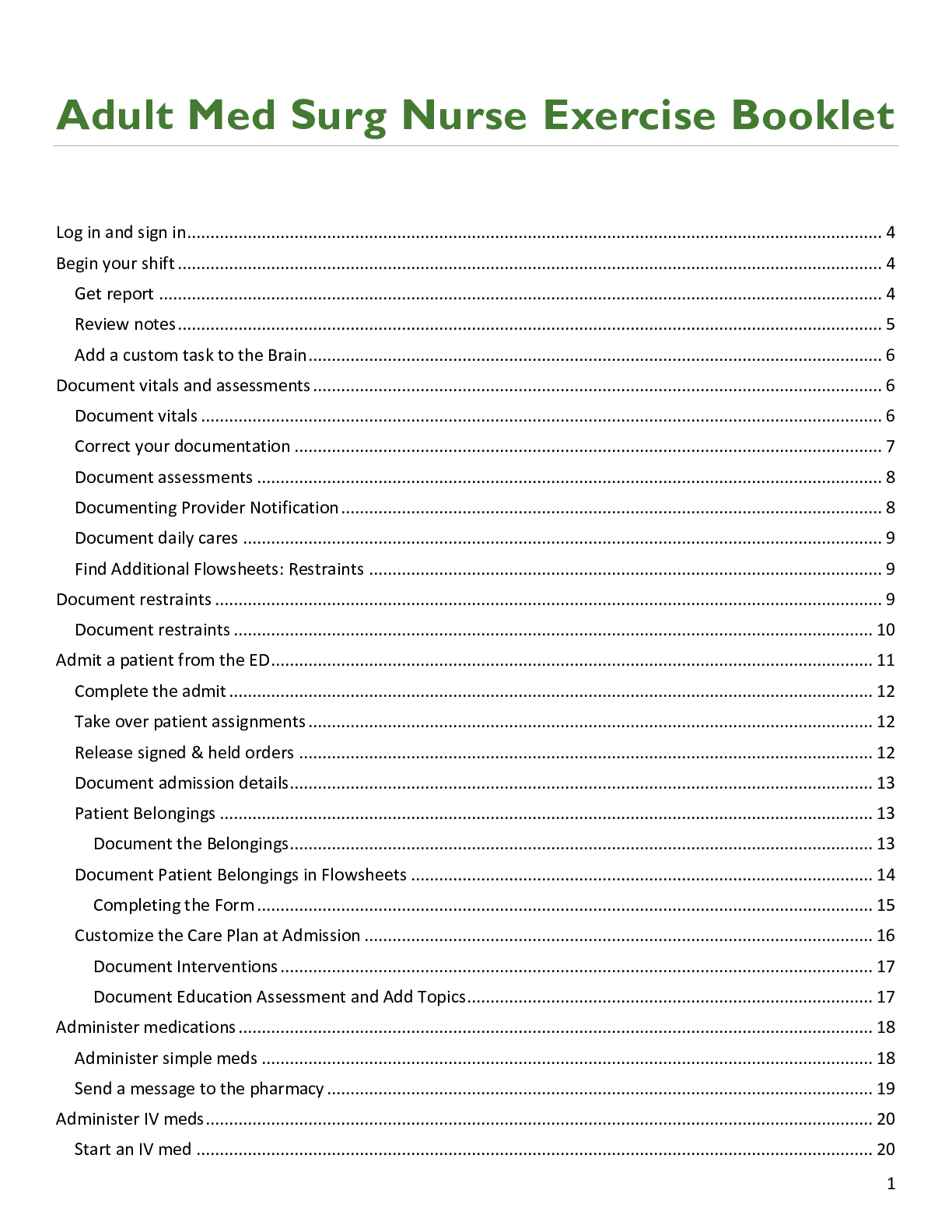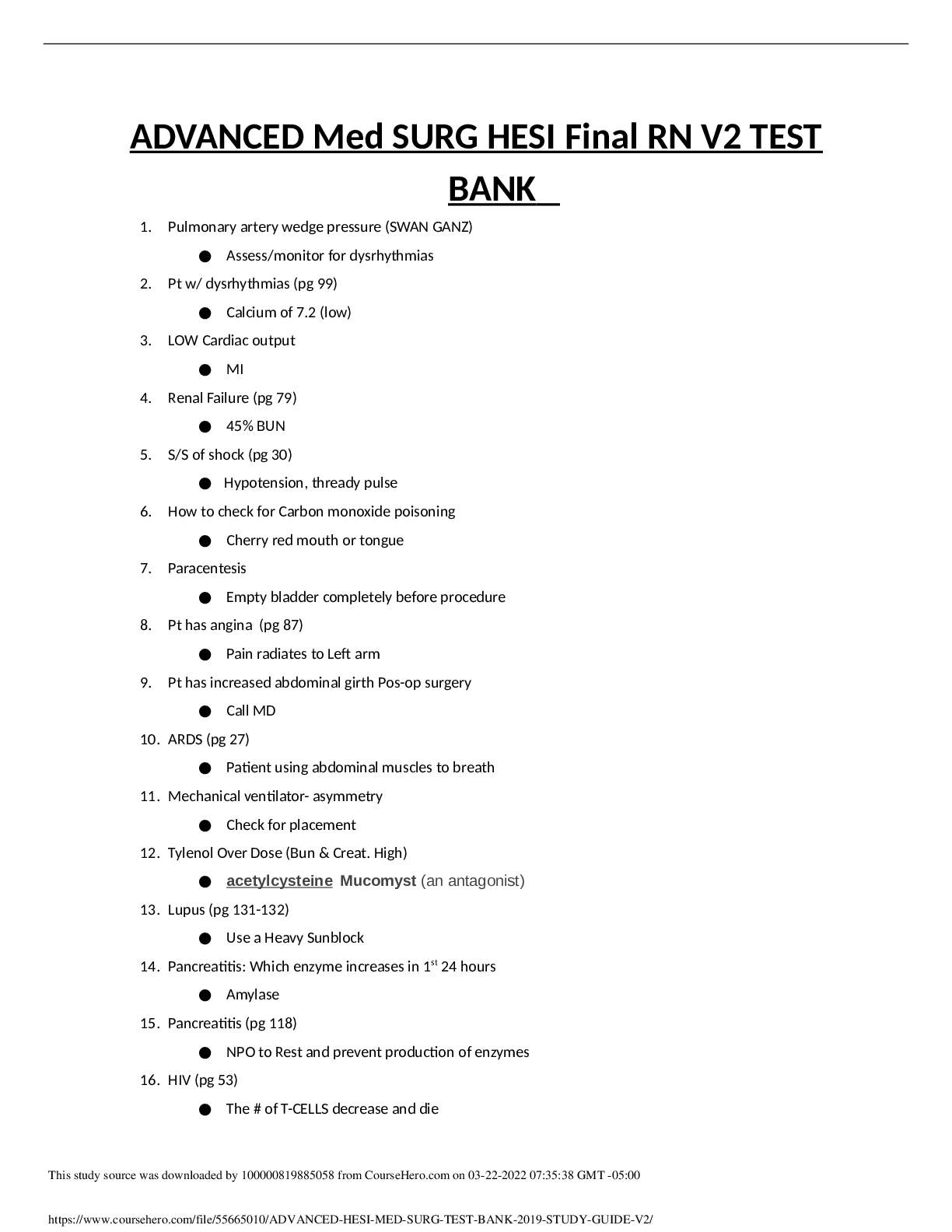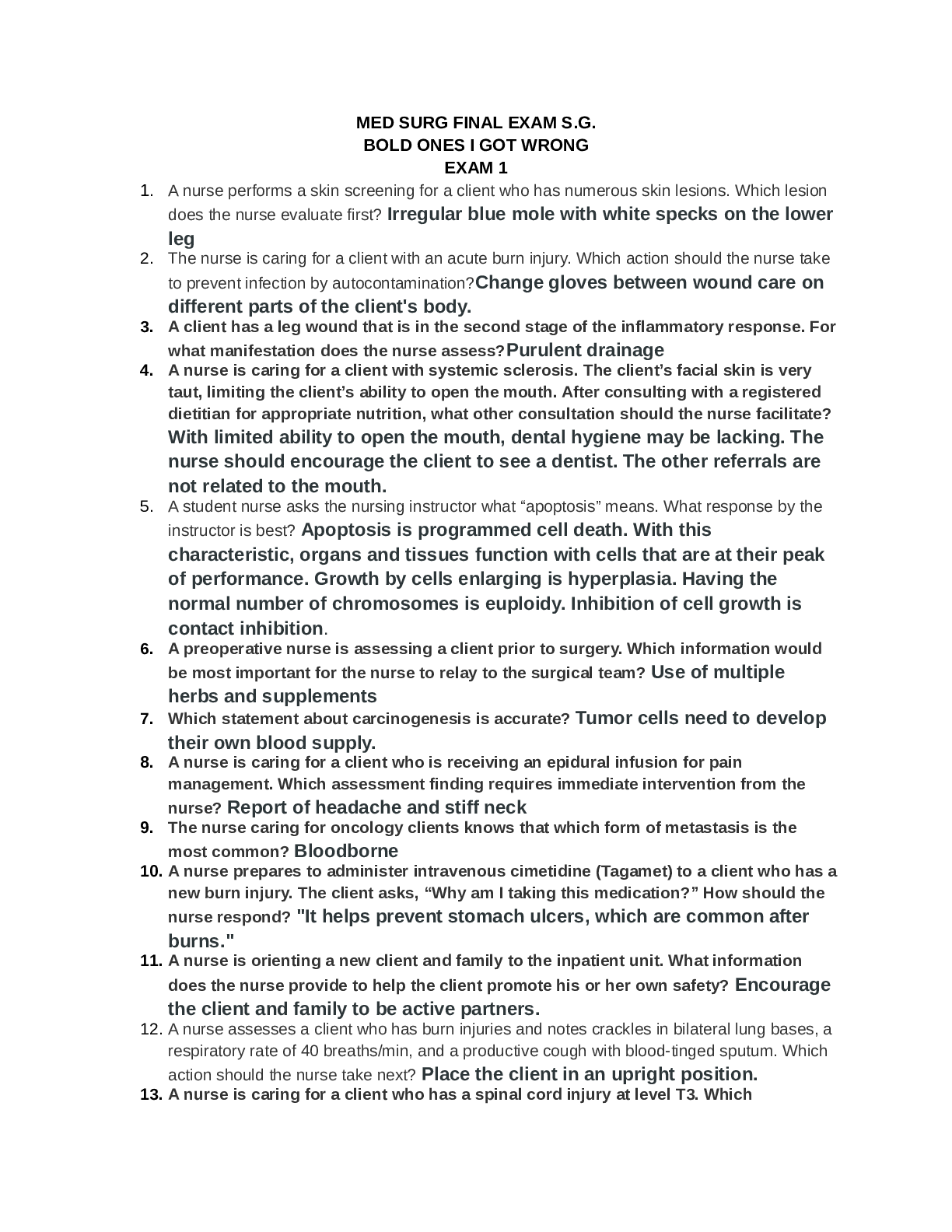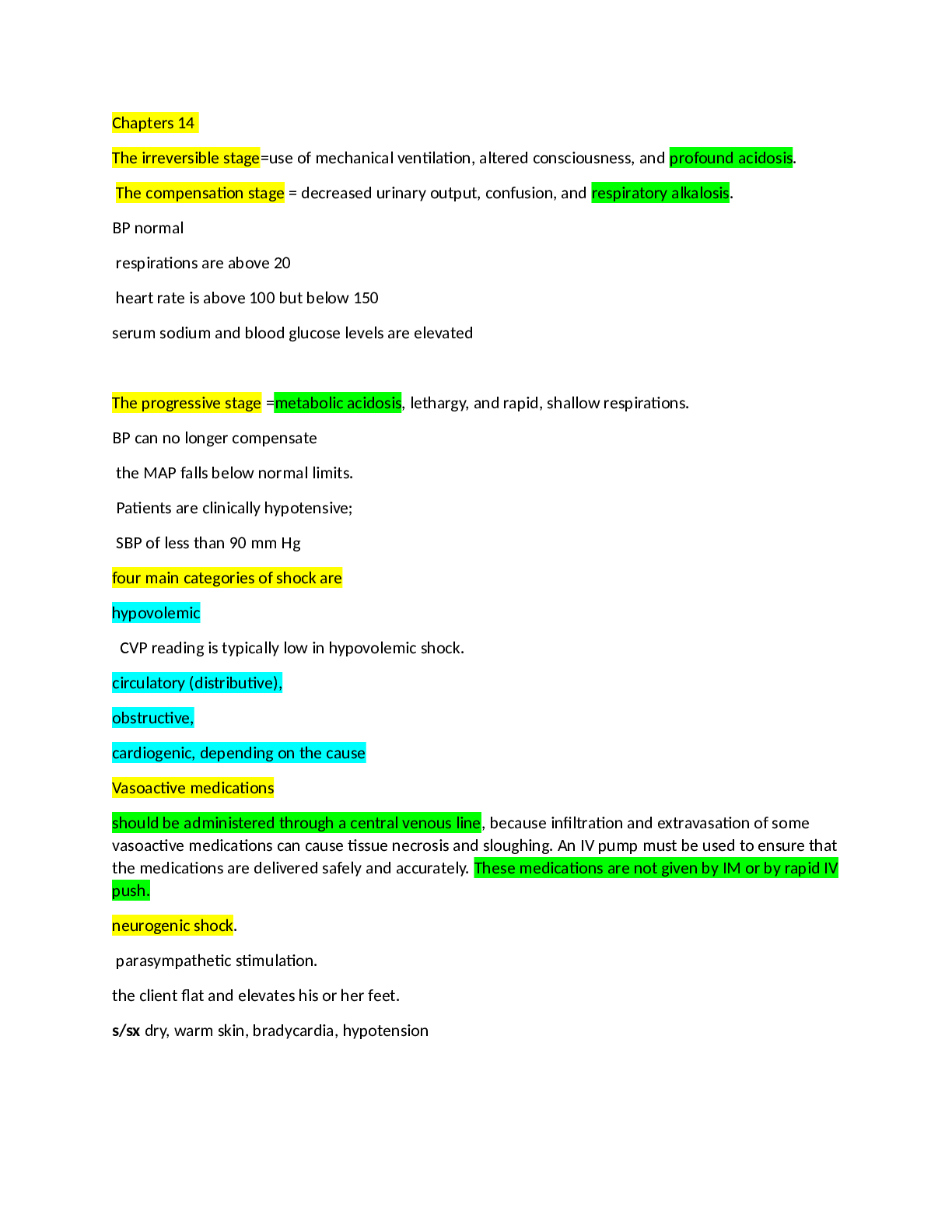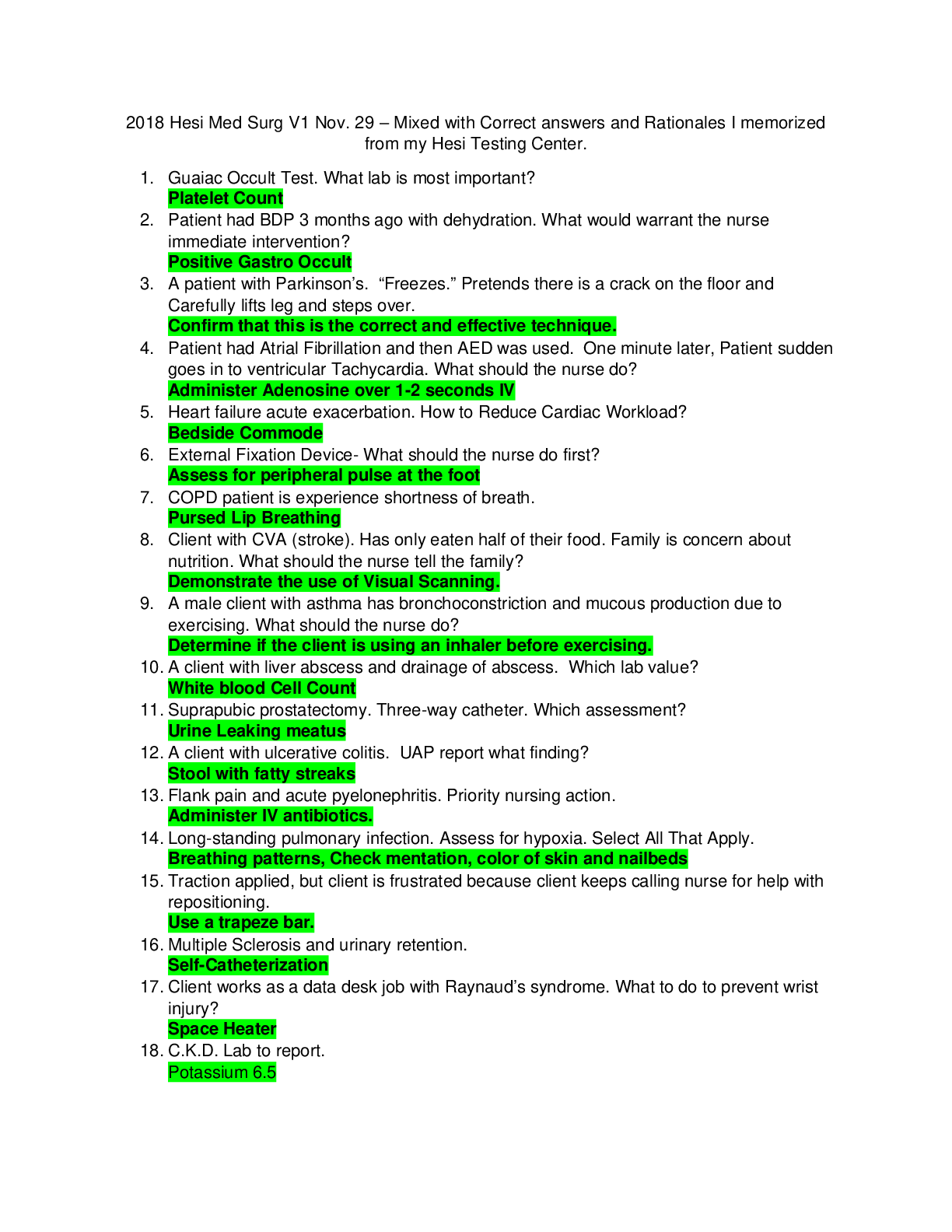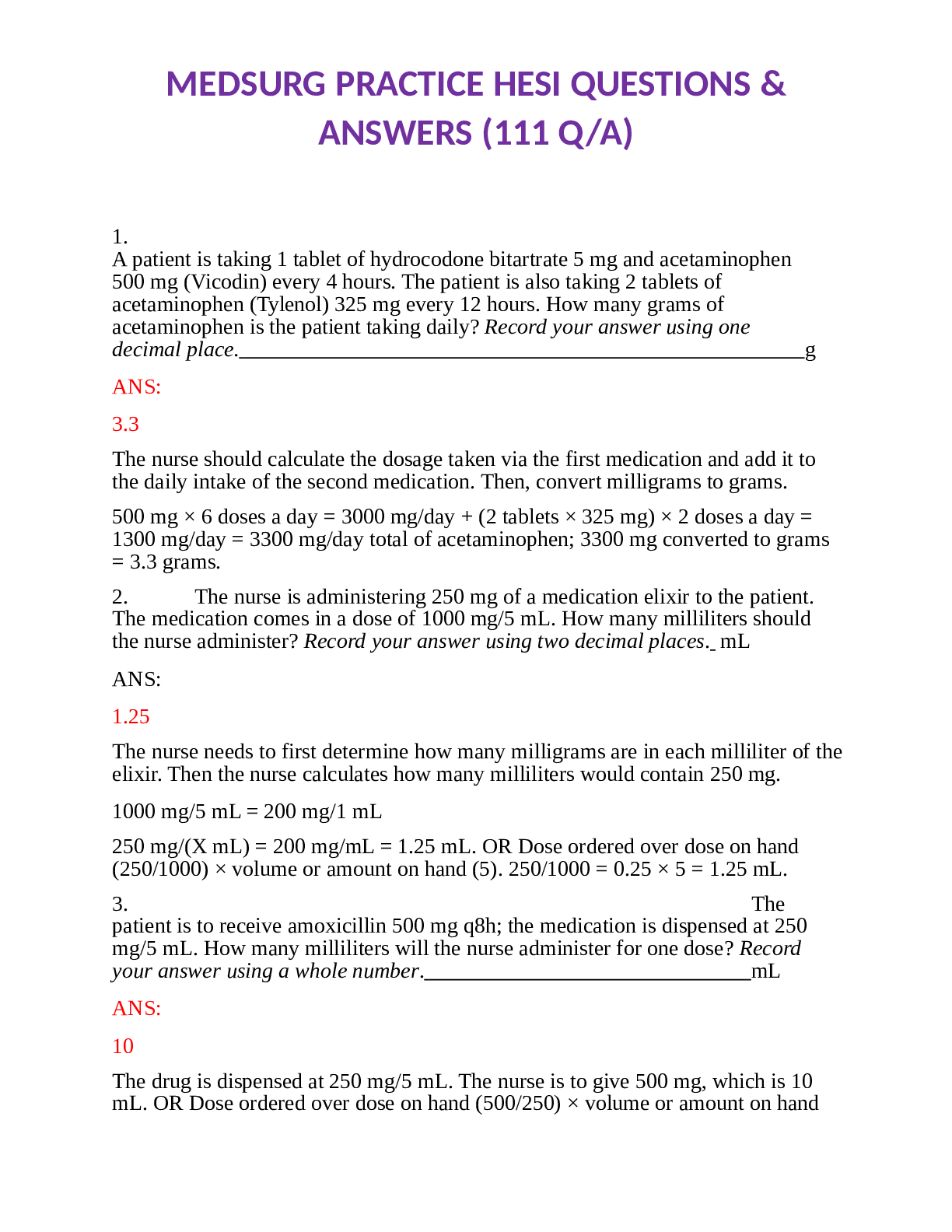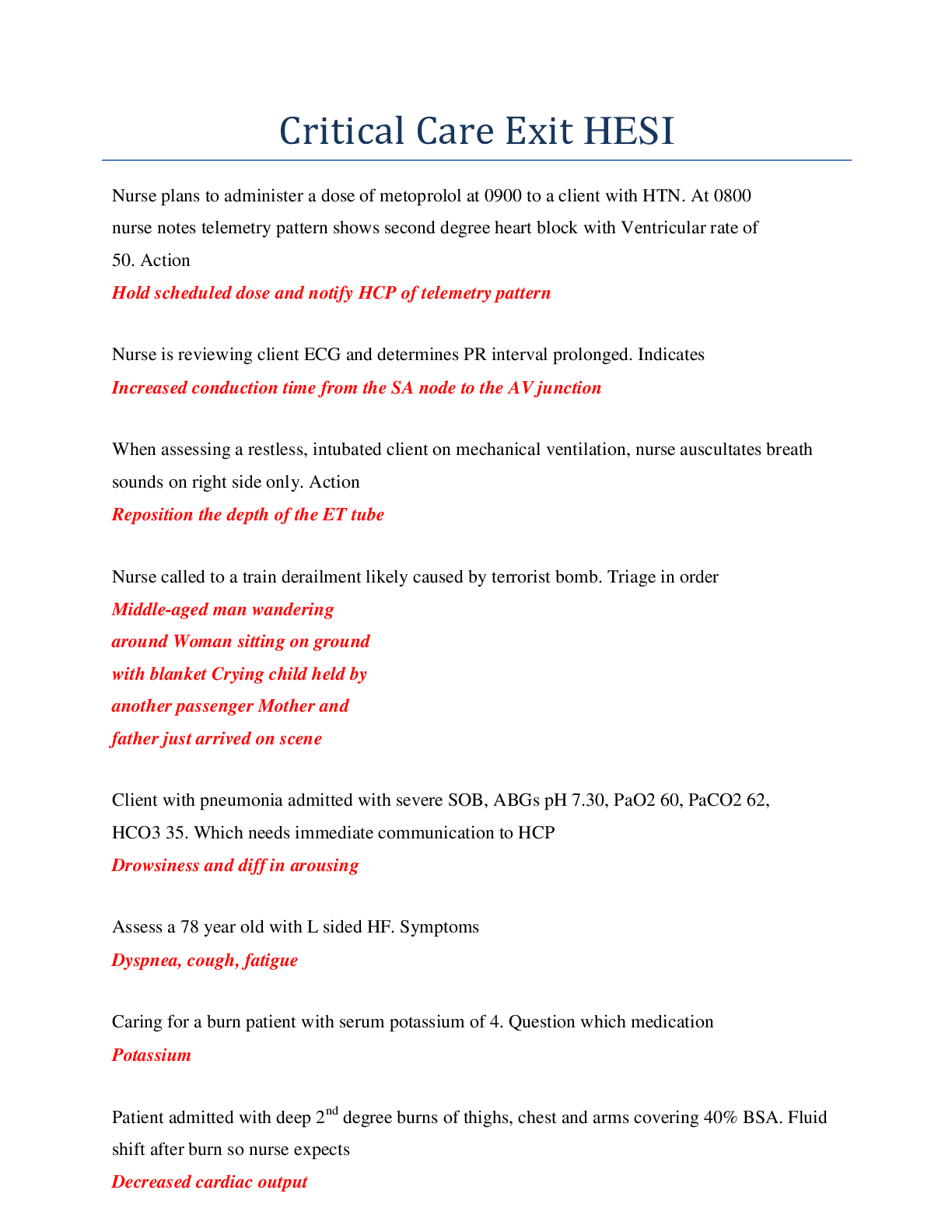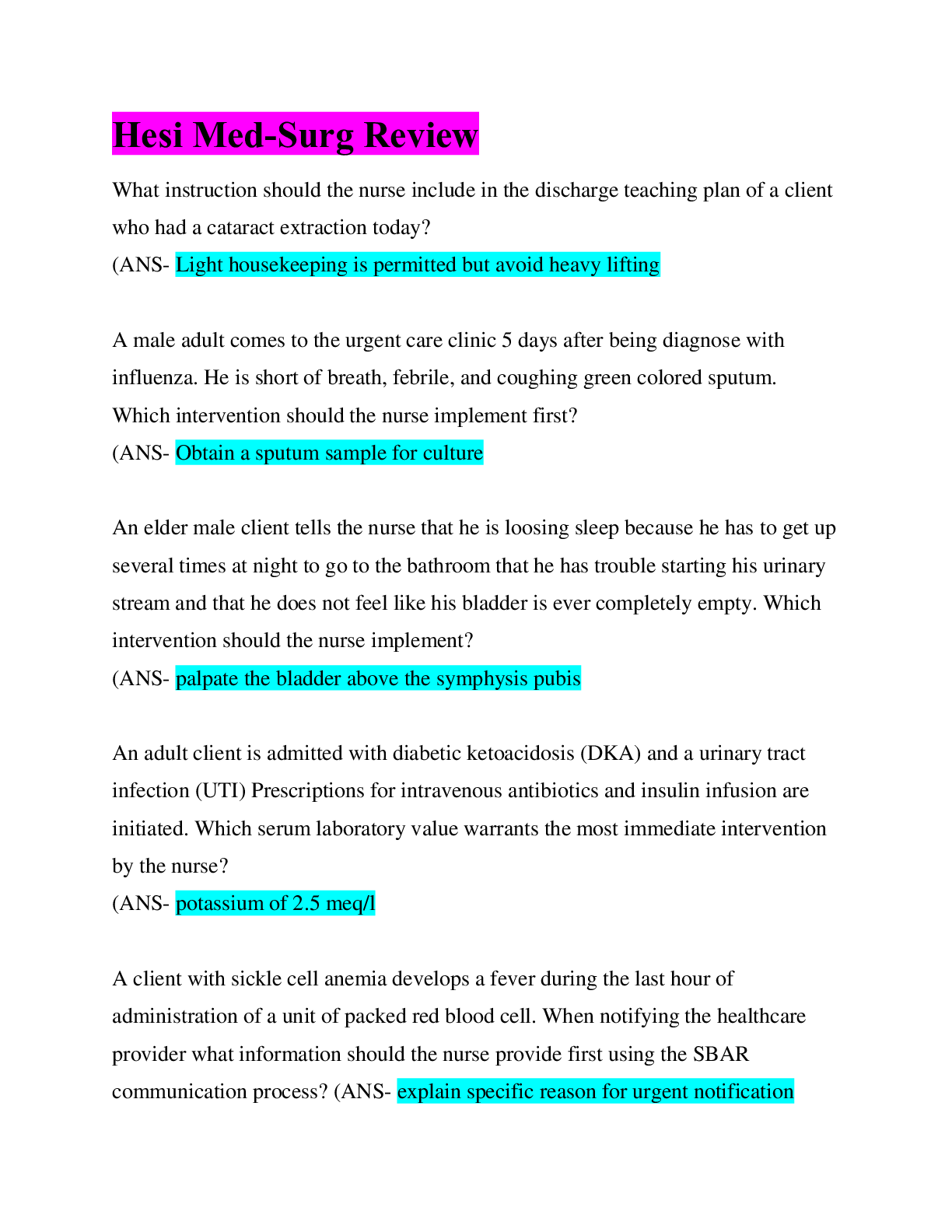*NURSING > HESI MED SURG > Med-Surg-Questions Final Exam Preparations Quality Questions & Answers Latest 2021 (All)
Med-Surg-Questions Final Exam Preparations Quality Questions & Answers Latest 2021
Document Content and Description Below
1. A home care nurse is preparing to visit a client with a diagnosis of Meniere’s disease. The nurse review’s the physician’s orders and expects to note that which of the following dietary mea... sures will be prescribed? A. low fiber diet with decreased fluids B. low sodium diet and fluid restriction C. low carbohydrate diet and elimination of red meats D. low fat with restriction of citrus fruits 2. A nurse is assigned to care for a client who has just undergone eye surgery. The nurse plans to instruct the client that which of the following activities is permitted in the postoperative period? A. reading B. watching television C. bending over D. lifting objects 3. A nurse is instilling an otic solution into an adult client’s left ear. The nurse avoids doing which of the following as part of this procedure? A. warming the solution to room temperature B. placing the client in a side lying position with the ear facing up C. pulling the auricle backward and upward D. placing the tip of the dropper on the edge of the ear canal 4. A client has undergone surgery for glaucoma. The nurse provides which discharge instructions to the clients? A. wound healing usually takes 12 weeks B. expected the vision will be permanently impaired C. a shield or eye patch should be worn to protect the eye D. the sutures are removed after 1 week 5. Which assessment findings provide the best evidence that a client with acute angleclosure glaucoma is responding to drug therapy? A. swelling of the eyelids decreases B. redness of the sclera is reduced C. eye pain is reduced or eliminated D. peripheral vision is diminished 6. At the time of retinal detachment, a client most likely describes which symptoms? A. a seeing flashes of light B. being unable to see light C. feeling discomfort in light D. seeing poorly in daylight 7. The most important health teaching the nurse can provide to the client with conjunctivitis is to: A. eat a well balanced, nutritious diet B. wear sunglasses in bright light C. cease sharing towels and washcloths D. avoid products containing aspirin 8. When the nurse prepares the client or the myringotomy, the best explanation as to the purpose for the procedures is that it will: A. prevent permanent hearing loss B. provide a pathway for drainage C. aid in administering medications D. maintain motion of the ear bones 9. A nurse is reviewing the record of the client with a disorder involving the inner ear. Which of the following would the nurse expect to see documented as an assessment finding in this client? A. severe hearing loss B. complaints of severe pain in the affected ear C. complaints of burning in the ear D. complaints of tinnitus 10. A client with a conduction hearing loss asks the nurse how a hearing aid improves hearing. The nurse most accurately informs the client that a hearing aid: A. amplifies sound heard B. makes sounds sharper and clearer C. produces more distinct, crisp, speech D. eliminates garbled background sounds 11. Which nursing action is best for controlling the client’s nosebleed? A. have the client lay down slowly and swallow frequently B. have the client lay down and breathe through his mouth C. have the client lean forward and apply direct pressure D. have the client lean forward and clench his teeth Situation: Benjie 59 years old male was admitted to the hospital complaining of nausea, vomiting, weight loss of 20 lbs, constipation and diarrhea. A diagnosis of carcinoma of the colon was made. 12. A sigmoidoscopy was performed as a diagnostic measures. What position Benjie should assume for hi examination? A. knee-chest B. Sim’s C. Fowler’s D. Trendelenburg 13. As part of the preparation of the client for sigmoidoscopy the nurse should: A. explain to Benjie that he will swallow a chalk-like substance B. administer a cathartic the night before C. withhold fluids and foods on the day of examination D. administer cleansing enema in the morning of the examination 14. The doctor performed a colostomy, post operative nursing care include: A. keeping the skin around the opening clean and dry B. limiting visitors C. withholding D. limiting fluid intake 15. During the irrigation of the colostomy, Benjie complains of abdominal cramps, the nurse should: A. discontinue the irrigation B. clamp the catheter for a few minutes C. advance the catheter about one inch D. add color water 16. If colostomy irrigation is done, the height of the irrigator can must be how many inches above the stoma? A. 14-18 inches B. 18-20 inches C. 20-24 inches D. 10-14 inches 17. Which of the following gastrointestinal condition is known to predispose to Cancer of the colon? A. hemorrhoids B. intussusception C. islated colonic polyps D. pyloric stenosis Situation: Mr. J was brought to the ER complaining of pain located in the upper abdomen hematemesis and melena. Diagnosis is peptic ulcer. 18. A frequent discomfort experience by Mr. J due to his peptic ulcer is: A. diarrhea B. vomiting C. eructation D. nausea 19. Which of this diagnostic measure is not indicated for Mr. J? A. x-ray of the abdomen B. patient’s history C. gastrointestinal series D. gastric analysis 20. The purpose of dietary treatment of Mr. J is to: A. neutralize the free HCL in the stomach B. delay gastric emptying C. prevent constipation D. delay surgery 21. Antacids are administered to Mr. J to: A. tranquilize the intestine B. decrease gastric motility C. lower the acidity of gastric secretion D. aid in digestion 22. It is thought that emotional stress contribute to ulcer formation through: A. excessive stimulation of the parasympathetic nervous system B. increased activity of the sympathetic nervous system C. disturbance o cerebral cortex appetite control D. decrease of pituitary function 23. The tissue change most characteristics of peptic ulcer is: A. a soft mass of the necrotic tissue with bleeding B. an erosion of the mucosa covered with thick exudates C. a sharp excavation of tissue membrane with a clean base D. an elevated fibrous tissue membrane with soft margins 24. The stool Guiac test was ordered to detect the presence of: A. hydrochloric acid B. occult blood C. inflammatory cells D. undigested food 25. In addition to its antacids effects, aluminum hydroxide gel is locally: A. analgesic B. astringent C. irritating D. depressant 26. Intervention that would help control his bleeding: A. gastric lavage using iced cold normal saline solution B. gastric using warm normal saline solution C. application of tourniquet D. insertion of NGT 27. Since she has NGT the appropriate nursing action is: A. render sponge bath B. provide laxative at bedtime C. administer enema once a day D. provide oral hygiene 3x a day 28. He underwent total gastrectomy, dumping syndrome may occur and the least symptoms he may experience would be: A. feeling of soreness B. weakness C. feeling of fullness D. diaphoresis 29. To prevent dumping syndrome the following includes your nursing care except: A. serve dry meals B. allow him to walk for a while after eating C. instruct him to lie down after eating D. giving of fluids after meals must be avoided 30. Your operative nursing assessment after surgery: A. note and report excessive bleeding only B. assess for excessive secretions from the operative site C. ensure that the NG tube is detached from suction apparatus D. check the drainage from the NG tube everyday 31. What is the involvement of her total gastrectomy? A. removal of the stomach only B. removal of the stomach with anastomosis of the esophagus to the jejunum C. removal of the ovary and fallopian tube D. removal of the stomach with anastomosis of the duodenal to jejunum 32. A nurse is giving instructions to the client with peptic ulcer disease about symptom management. The nurse tells the client to: A. eat slowly and chew food thoroughly B. eat large meals to absorb gastric acid C. limit the intake of water D. use acetylsalicylic acid (aspirin) to relieve gastric pain 33. A client has been given a prescription for Propantheline (Probanthine) as adjunctive treatment for peptic ulcer disease. The nurse tells the client to take this medication: A. with antacids B. 30 minutes before meals C. with meals D. just after meals Situation: Kim was known to be alcoholic for 15 yrs. He was admitted in the hospital after having vomited a large quantity of bright red blood with some coffee ground appearance. 34. The most probable cause of Kim’s cirrhosis is: A. malnutrition B. bacterial inflammation of liver cells C. alcoholism D. obstruction of major bile ducts 35. Which of the following vitamins are stored by the normal liver? A. vit. A, vit. B and vit. C B. vit. A, vit. B, vit. C, and vit. D C. vit A and vit B D. vit. A and vit. C 36. The nurse should know how that pathophysiology predispose him to: A. varicose veins B. splenic rupture C. inguinal hernia D. umbilical hernia 37. Kim’s portal hypertension is the result of: A. contraction of vascular muscles response to psychological stress B. compression of the liver substance due to emotional stress C. acceleration of portal blood flow secondary to severe anemia D. twisting and constriction of intralobular and interlobular blood vessels 38. Kim is scheduled for a liver biopsy. What instructions regarding respiration is essential for the nurse to give him prior to the biopsy: A. exhale forcefully and to hold his breath for a few seconds B. hold his breath when the needle has reached the liver site C. take several deep breaths and to hold his breath while needle is being introduced D. flat with one pillow under his head 39. Which position in bed would be best for Kim immediately after he has the needle biopsy of the liver? A. on his right side, with a small pillow under the costal margin B. anyway that he is comfortable C. semi-Fowler’s with his knees flexed D. flat with one pillow under his head 40. A Blakemore-Sengstaken tube is inserted to prevent bleeding from esophageal varices. The nurse responsibility in this instance would be to: A. alternate inflate and deflate the esophageal balloon B. make certain that the desired degree of pressure is constantly maintained C. deflate both balloons periodically D. encourage Kim to swallow frequently while tube is I place 41. A physician orders the deflation of the esophageal balloon of a SengstakenBalkemore tube in a client. The nurse prepares for the procedure knowing that the deflation of the esophageal balloon places. The client is at risk for: A. increased ascites B. esophageal necrosis C. recurrent hemorrhage from the esophageal varices D. gastritis 42. Foods usually omitted from diet of Kim with cirrhosis of liver are: A. whole grain cereals B. milk products C. cereal products D. rich gravies and sauces 43. Clay colored stool are caused by: A. improper utilization of vitamin K by the body B. the absence of bile salt in the feces C. the absence of bile pigments in the urine D. rich gravies and sauces 44. Kim develop ascites, this is caused by: A. pulmonary failure B. portal obstruction C. capillary obstruction D. arterial obstruction 45. Symptoms indicating progression into hepatic coma include: 1. flapping tremor 2. nystagmus 3. fruity odor breath 4. fetid breath A. 2 and 4 C. 2 and 3 B. 1 and 4 D. 1 and 3 46. A client admitted to the hospital with a diagnosis of cirrhosis has massive ascites and has difficulty breathing. A nurse performs which intervention as a priority measure to assist the client with breathing? A. auscultates the lung fields every 4 hours B. repositions side to side every 2 hours C. encourages deep breathing exercises every 2 hours D. elevates the head of the bed 60 degrees Situation: Karla is confine with a diagnosis of chronic cholecystitis. 47. After thorough examination your findings would be: A. high red blood cell counts and fever B. leukocyte count is low and high fever C. leukocyte count high and pyrexia D. leukocytosis and abdominal pain that radiates to the groin 48. The surgical intervention indicated for Karla is: A. choledochostomy B. cholecystostom [Show More]
Last updated: 2 years ago
Preview 1 out of 103 pages

Buy this document to get the full access instantly
Instant Download Access after purchase
Buy NowInstant download
We Accept:

Reviews( 0 )
$12.50
Can't find what you want? Try our AI powered Search
Document information
Connected school, study & course
About the document
Uploaded On
Mar 26, 2021
Number of pages
103
Written in
Additional information
This document has been written for:
Uploaded
Mar 26, 2021
Downloads
0
Views
138

